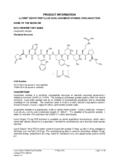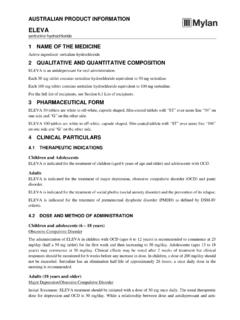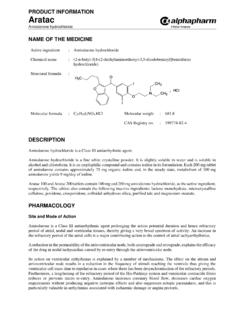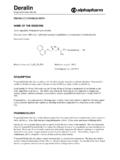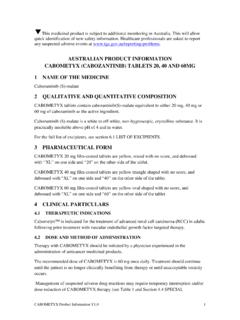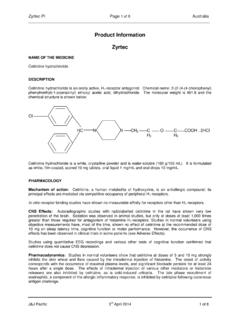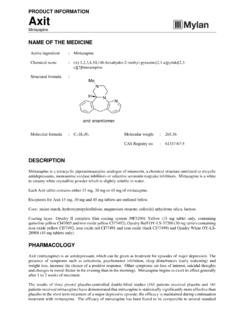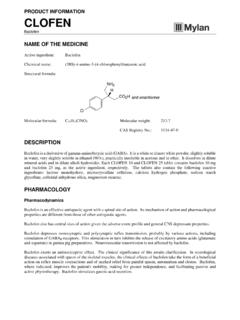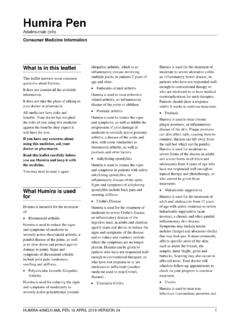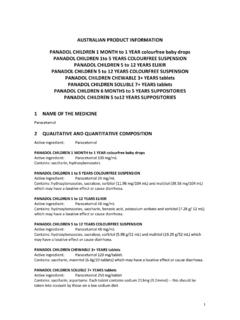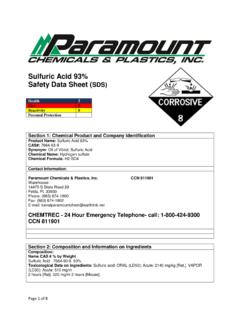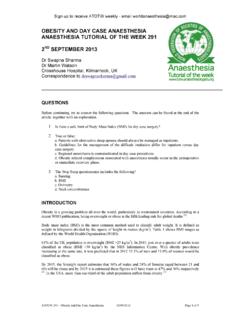Transcription of PRODUCT INFORMATION Kalma - Medicines
1 PRODUCT INFORMATION Kalma Alprazolam NAME OF THE MEDICINE Active ingredient : Alprazolam Chemical name : 8-chloro-1-methyl-6-phenyl-4H-S-triazolo (4,3- )(1,4)-benzodiazepine Structural formula : Molecular formula : C17H13 ClN4 Molecular weight : CAS Registry no. : 28981-97-7 DESCRIPTION Kalma tablets contain alprazolam, an anti-anxiety, benzodiazepine derivative chemically and pharmacologically related to other drugs of this class. Alprazolam is a white crystalline powder which is soluble in methanol or ethanol but has no appreciable solubility in water. Each Kalma tablet contains mg of alprazolam; each Kalma tablet contains mg of alprazolam; each Kalma 1 tablet contains 1 mg of alprazolam; each Kalma 2 tablet contains 2 mg of alprazolam. Kalma , Kalma , Kalma 1 and Kalma 2 tablets also contain lactose monohydrate, microcrystalline cellulose, maize starch, sodium benzoate, docusate sodium, povidone, colloidal anhydrous silica, sodium starch glycollate, magnesium stearate.
2 Kalma tablets also contain erythrosine CI 45430 ( Kalma only) and indigo carmine CI 73015 ( Kalma and Kalma 1 only). PHARMACOLOGY Pharmacological properties of alprazolam in animals appear similar to those of other benzodiazepines, that is, it produces significant anxiolytic, muscle relaxant, sleep promoting and anticonvulsant effects in appropriate animal models. The exact site and mechanism of action of benzodiazepines is unknown. It is known that they act within the CNS as selective depressants. Clinical studies in healthy volunteers with doses up to 4 mg/day, and in patients with panic disorder at doses up to 10 mg/day, produce only effects which can be considered to be extensions of its pharmacological activities. Kalma PRODUCT INFORMATION 2 No clinically significant effects on the cardiovascular or respiratory systems were observed. Alprazolam doses up to 10 mg/day do not clinically affect laboratory parameters or vital signs.
3 Sleep laboratory studies in humans showed that alprazolam decreased sleep latency, increased duration of sleep and decreased the number of nocturnal awakenings. Alprazolam produced small decreases in both stages 3 to 4 and rapid eye movement (REM) sleep. Pharmacokinetics Absorption Following oral administration to fasting subjects, alprazolam is rapidly absorbed with almost complete bioavailability. Alprazolam exhibits linear kinetics; after single dose administration of to 3 mg, plasma levels of 8 to 40 nanogram/mL were observed; during multiple dose administration of to 10 mg/day in divided doses, steady state plasma levels of to 100 nanogram/mL were observed. Plasma levels of drug reach steady state within 7 days after starting or altering dosage size. The steady state level is 3 to 4 times that achieved with a single dose. Peak plasma levels showed a two- to three-fold variation within individual treatment groups.
4 The plasma half-life of alprazolam after single doses in healthy subjects has ranged from 6 to 25 hours. The mean half-life of individual treatment groups ranged from 10 to 14 hours. Distribution In vitro alprazolam is bound (80%) to human serum protein. Serum albumin accounts for the majority of the binding. Metabolism Alprazolam is extensively metabolised in humans, primarily by cytochrome P450 3A4 (CYP3A4), to two major metabolites in the plasma: 4-hydroxyalprazolam and -hydroxyalprazolam. A benzophenone derived from alprazolam is also found in humans. Their half-lives appear to be similar to that of alprazolam. The plasma concentrations of 4-hydroxyalprazolam and -hydroxyalprazolam relative to unchanged alprazolam concentration were always less than 4%. The reported relative potencies in benzodiazepine receptor binding experiments and in animal models of induced seizure inhibition are and , respectively, for 4-hydroxyalprazolam and -hydroxyalprazolam.
5 Such low concentrations and the lesser potencies of 4-hydroxyalprazolam and -hydroxyalprazolam suggest that they are unlikely to contribute much to the pharmacological effects of alprazolam. The benzophenone metabolite is essentially inactive. Elimination Alprazolam and its metabolites are excreted primarily in the urine. In addition to alprazolam, the major drug-related materials excreted in urine are -hydroxyalprazolam, and a benzophenone analog. About 50 percent of the dose is excreted within 24 hours, and 94 percent after 72 hours. With chronic dosing, the apparent elimination half-life increases by about 50 percent, possibly because of compartmentalisation effects. Special Populations Changes in the absorption, distribution, metabolism and excretion of benzodiazepines have been reported in a variety of disease states including alcoholism, impaired hepatic function and impaired renal function.
6 Changes have also been demonstrated in the elderly. (See Precautions.) Race - Maximal concentrations and half-life of alprazolam are approximately 15% and 25% higher in Asians compared to Caucasians. Cigarette Smoking - Alprazolam concentrations may be reduced by up to 50% in smokers compared to non-smokers. Kalma PRODUCT INFORMATION 3 INDICATIONS Anxiety Short-term symptomatic treatment of anxiety including treatment of anxious patients with some symptoms of depression. Panic disorder The treatment of panic disorder with or without some phobic avoidance, and for blocking or attenuation of panic attacks and phobias in patients who have agoraphobia with panic attacks. The diagnostic criteria for panic disorder in DSM-III-R are as follows: The panic attacks (discrete periods of intense fear or discomfort), at least initially, are unexpected. Later in the course of this disturbance, certain situations ( driving a car or being in a crowded place) may become associated with having a panic attack.
7 These panic attacks are not triggered by situations in which the person is the focus of others' attention (as in social phobia). The diagnosis requires four such attacks within a four week period, or one or more attacks followed by at least a month of persistent fear of having another attack. The panic attacks must be characterised by at least four of the following symptoms: dyspnoea or smothering sensations; dizziness, unsteady feelings or faintness; palpitations or tachycardia; trembling or shaking; sweating; choking; nausea or abdominal distress; depersonalisation or derealisation; paraesthesiae; flushes (hot flashes) or chills; chest pain or discomfort; fear of dying; fear of going crazy or of doing something uncontrolled. Note. Attacks involving four or more symptoms are panic attacks; attacks involving fewer than four are limited symptom attacks. At least some of the panic attack symptoms must develop suddenly and increase in intensity within ten minutes of the beginning of the first symptom noticed in the attack.
8 The panic attack must not be attributable to some known organic factor, amphetamine or caffeine, intoxication, hyperthyroidism. The efficacy of alprazolam in conditions where the above criteria are not met has not been established. The risk versus benefits of alprazolam use in milder disorders, which do not meet the above criteria, has not been evaluated. Although current evidence supports the long-term clinical effectiveness of alprazolam in panic disorder, the continuing use of alprazolam needs to be weighed against the difficulties that can occur with dependence and discontinuation. The results of a long-term study in patients taking alprazolam (ie. beyond three months) suggest that many patients continue to benefit from alprazolam therapy and that alprazolam efficacy is maintained for up to eight months. The physician should periodically reassess the usefulness of the drug for each patient.
9 A comparative study of alprazolam and placebo in the treatment of panic attacks in patients with panic disorder involved 543 patients over an eight week period. Alprazolam was significantly more effective than placebo in reducing the total number of panic attacks (p < ); at week 4, of alprazolam patients had achieved zero total panic attacks when compared to of placebo patients. Panic disorders are often severe, chronic illnesses that cause a high level of work and social disability, increased substance abuse and potentially increased morbidity and mortality. Psychological and social factors are important in the pathogenesis of panic attacks, either acting alone or in combination with biological factors. Prolonged pharmacological therapy may be used as an adjunct to psychosocial therapy in the treatment of patients with panic disorders. Kalma PRODUCT INFORMATION 4 CONTRAINDICATIONS Kalma is contraindicated in: Known hypersensitivity to benzodiazepines.
10 Chronic obstructive airways disease with incipient respiratory failure. Myasthenia gravis. PRECAUTIONS Effects on Ability to Drive and Use of Machines As with all patients taking CNS-depressant medications, patients receiving Kalma should be warned not to operate dangerous machinery or motor vehicles until it is known that they do not become drowsy or dizzy from Kalma therapy. Abilities may be impaired on the day following use. Patients should be advised that their tolerance for alcohol and other CNS depressants will be diminished and that these medications should either be eliminated or given in reduced dosage in the presence of Kalma . Following the prolonged use of Kalma at therapeutic doses, withdrawal from the medication should be gradual. An individualised withdrawal timetable needs to be planned for each patient in whom dependence is known or suspected. Periods from four weeks to four months have been suggested.
